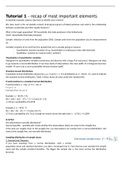College aantekeningen
MAT-15403 Lectures Statistics 2
- Instelling
- Wageningen University (WUR)
Lecture summary of the course Statistics 2 (MAT) at Wageningen University (WUR). Slides included as examples to give an extensive overview. Combination of Dutch and English.
[Meer zien]




